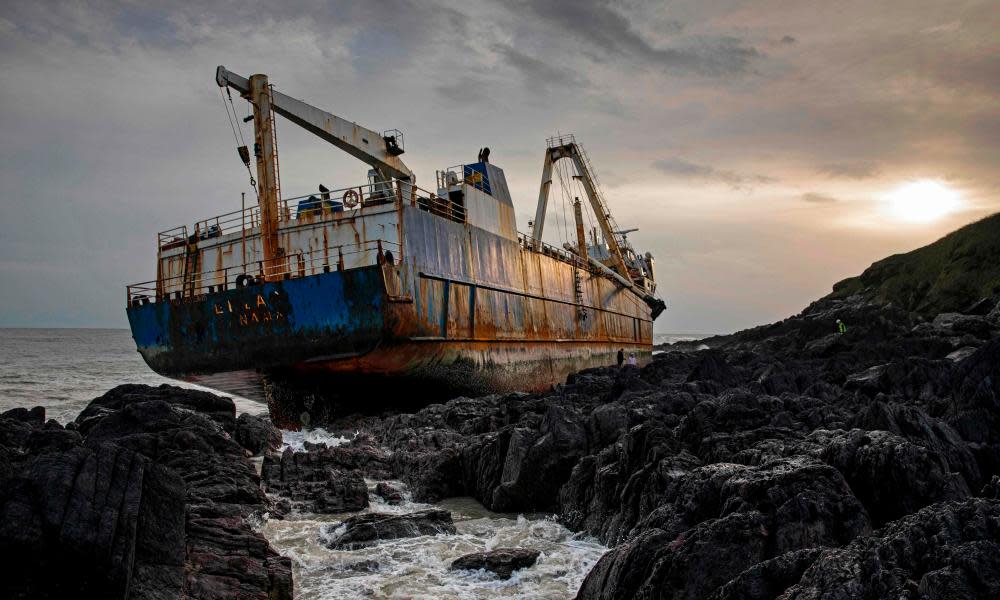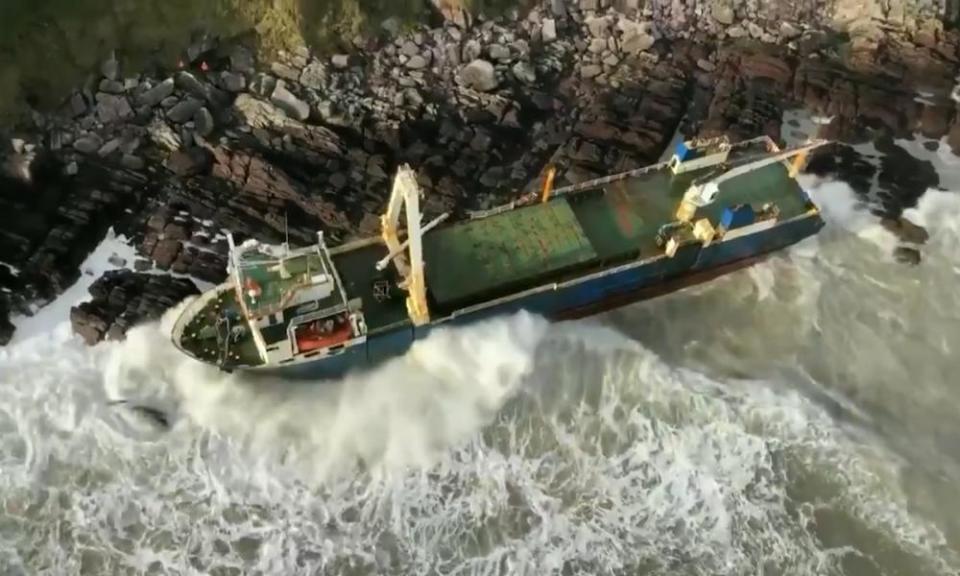Irish contractors get first look at grounded ‘ghost ship’ MV Alta

It leans on the rocks at an almost jaunty angle, framed by the horizon whence it came, not a soul in sight.
MV Alta, a ghost ship that traversed the Atlantic for more than a year without crew or passengers, berthed at last.
The 77-metre cargo vessel’s odyssey came to an end during Storm Dennis last Sunday when it ran aground near Ballycotton, a fishing village in County Cork, Ireland, overlooking the Celtic Sea.
Photographers gained access to the site on Wednesday, giving the first proper close-up look at a ship that has caught the public’s imagination. A local coast guard official called the landing a one in a million chance.

For a derelict ruin it looked rather impressive: hulking steel, largely intact, with a navy blue hull offering a vivid contrast to grey skies and sea.
A person claiming to represent the Alta’s owner has contacted Ireland’s revenue commissioners, who act as “receiver of wreck”, a statutory function. “An individual purporting to represent the owner has made contact,” a spokesman said in a brief statement. He declined to elaborate.
Built in 1976, the Alta was flagged in Tanzania, changed owner in 2017 and was sailing from Greece to Haiti in September 2018 when it become disabled about 1,380 miles (2,220km) south-east of Bermuda.
Two days ago @hmsprotector discovered this apparently abandoned Merchant Vessel whilst mid-Atlantic. We closed the vessel to make contact and offer our assistance, but no one replied! Whilst investigations continue we’re unable to give you more detail on this strange event.🌊🚢🇬🇧 pic.twitter.com/x29sB5IF06
— HMS Protector (@hmsprotector) September 2, 2019
Unable to make repairs, the 10-strong crew was rescued by the US coastguard cutter Confidence, which brought the crew members to Puerto Rico.
The ship was reportedly towed to Guyana and then hijacked, with its subsequent fate unclear until August 2019 when a Royal Navy ice patrol ship, HMS Protector, encountered it in the mid-Atlantic, apparently unmanned.
It is thought to have later drifted up from Africa and past Spain to Ireland, a solitary counterpoint to the cruise liners in Asia jammed with passengers facing quarantine because of the coronavirus.

Marine contractors working for Cork County Council boarded the freighter on Tuesday and carried out a preliminary examination of the ship and any pollution risk from potential fuel spillage.
Not all fuel tanks were accessible but initial indications suggested they held only a small amount of diesel fuel.
There is no cargo on board but some sealed containers with oil could pose a pollution risk in the event of spillage, the council said in a statement.
The contractor was due to start pumping water from the vessel on Wednesday, and there are plans to remove the containers.
The council expressed alarm at reports that members of the public had boarded the wreck, saying this was extremely perilous. “It is located on a dangerous and inaccessible stretch of coastline and is in an unstable condition.”
Ghost ships, mythical and real, are part of ocean lore.
The Flying Dutchman, supposedly doomed never to make port, is a legend dating from the 1700s. The Mary Celeste was real, discovered adrift off the Azores in 1872, the crew’s fate a mystery.
More recently, in 2006 the tanker Jian Seng was found off the coast of Queensland, Australia, without a crew, the identity of its owner and its origins unclear.
In 2016 a wooden houseboat washed ashore on Ireland’s Atlantic coast. Made with driftwood and polystyrene and fitted with solar panels, it turned out to have been built by Rick Small, a Canadian environmentalist who had given the boat away and had no idea how it ended up crossing the ocean unmanned.


